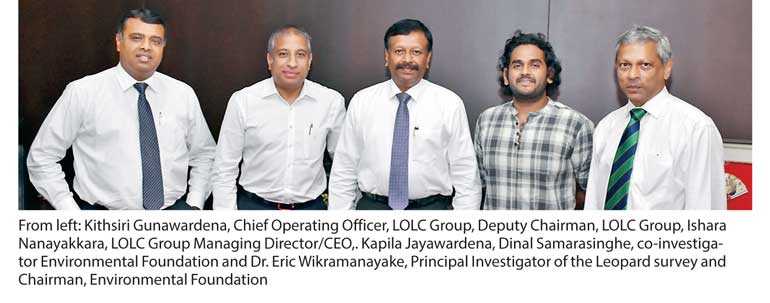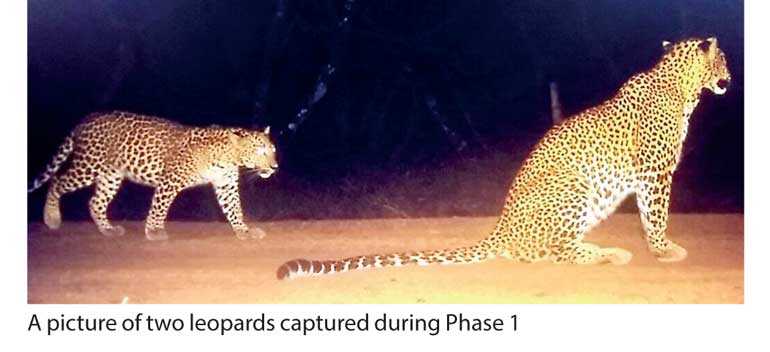Friday Jan 16, 2026
Friday Jan 16, 2026
Wednesday, 18 July 2018 00:00 - - {{hitsCtrl.values.hits}}


The World Wildlife Fund states that the rapid loss of wildlife species today is estimated to be up to 10,000 times higher than the natural extinction rate. According to WWF, we are watching them disappear on a daily basis, mostly due to human-caused habitat destruction and climate change.
Having recognised the importance of high quality research in protecting the endangered Sri Lankan Leopard, LOLC, one of Sri Lanka’s leading and largest diversified conglomerates has stepped forward to support the ‘Standardised Population Survey of the Sri Lankan Leopard in the Wilpattu National Park’. This six-month project is spearheaded by the Environmental Foundation Ltd., the Department of Wildlife Conservation of Sri Lanka, and ‘For The Leopard Trust’. The cheque to fund the project was handed over to the Environmental Foundation Ltd. at the LOLC Head Office in Rajagiriya, recently.
The leopard is one of the five species of “Big Cats” in the world along with the Tiger, Lion, Jaguar and the Snow Leopard. Only nine subspecies of leopards including the Sri Lankan Leopard Panthera pardus kotiya have been recognised in the world and our Leopard, is the second remaining “island Leopard” in the world. This unique big cat is our apex predator and is categorised as an endangered species by the IUCN (The International Union for Conservation of Nature) primarily due to loss of habitat. The conservation of Leopards is particularly meaningful given that Sri Lanka currently holds a unique leopard subspecies that is increasingly limited to a relatively small area of occurrence.
Furthermore, Sri Lanka’s national parks are listed amongst the world’s best places to observe Leopards. Therefore, the Leopard is an important wildlife species in terms of Sri Lanka’s nature based tourism strategy. However, due to the limited information concerning the status of the Leopard population, the national efforts to conserve this iconic, flagship species remains at a very premature stage.
Speaking about the project, Environmental Foundation Ltd. Principal Investigator and Chairman Dr. Eric Wikramanayake said, “This survey at Wilpattu will provide the first robust and scientifically defensible estimates of Leopards in Wilpattu, after which we hope to continue this survey in other major protected areas of Sri Lanka. The data will establish a reliable baseline to inform long-term population monitoring and conservation programs. The objective of this survey is to estimate Leopard densities using Leopard photographic data which will be used in spatially explicit capture – recapture analysis (SECR) in the Wilpattu National Park.”
The methodology used for this population survey is an internationally accepted protocol that uses two systematically set up camera traps. The camera traps, spaced about 2-3 kilometres apart, will be left active for a period of 40 days and checked regularly. This spatial configuration ensures that all Leopards in the landscape will have an equal probability of being detected. The unique spot patterns allow the identification of the individual Leopards. The information will be used in a spatial model to estimate the total population in the park.
Dr. Wikramanayake added, “We are immensely encouraged by our partnership with LOLC. It will reinforce our conservation efforts and ensure that such iconic species are not affected along Sri Lanka’s journey towards economic progress and development. Corporate partners like LOLC have recognised the importance of protecting Sri Lanka’s wildlife and we are pleased to work closely with corporates who have understood the essence of wildlife conservation.”
Dinal Samarasinghe who is leading the field work noted that Phase 1 of the camera trapping programme covering the Eastern section of the Wilpattu National Park has been completed. The analysis shows at least 77 individual Leopards in a 350 square kilometre area of the park. Dinal said, “Phase 2, for which we received funding support from LOLC will cover the entire Western section as well as a small section in the middle of the Park. Paired camera trap stations will be similarly deployed and monitored for 40 days and on completion we will derive a robust population estimate for the entire park.”
Speaking about the Population Survey of the Sri Lankan Leopard in the Wilpattu National Park, LOLC Group Managing Director/CEO Kapila Jayawardena stated, “LOLC is extremely happy to support this project which is of great national significance. We are proud to partner and support the efforts of the Environmental Foundation and the Department of Wildlife Conservation to protect endangered species such as the majestic and iconic Sri Lankan Leopard. We understand that these conservation efforts require adequate financing and it is not the sole responsibility of conservation organisations such as the EFL. That is why we stepped forward to support such important projects which aims to protect and conserve Sri Lanka’s wildlife. We as a corporate will continue to engage in similar conservation efforts that focus on creating a sustainable ecosystem for both people and wildlife.”
LOLC Group Chief Operating Officer Kithsiri Gunawardena said, “The Leopard is a magnificent hunter and the top predator in our jungles. As it is a flagship species its protection will support the conservation of many other species. As an avid leopard enthusiast engaged in the study of Leopards in Wilpattu, in my spare time, today I’m extremely pleased and proud that we are supporting this project spearheaded by EFL and the Department of Wildlife Conservation and look forward to even better measures being taken to ensure the long term conservation of Leopards in the country. LOLC is quite conscious of the value of our unique bio diversity and the important role the corporate sector can play in supporting conservation.”